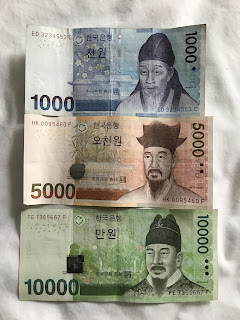Some people got to have it, some people real need it but what we have to do is withdrawal and exchange it. Every country we have gone to so far has had it challenges either trying to exchange our hard earned dollars or trying to spend our new currency. 💴💵💳
Years ago you had no problem getting your money exchanged as long as you had Traveler’s Cheques and stood in line at the local bank with your passport in hand. Because these checks had a high propensity for fraud they were slowly fazed out. Then came the use of ATM machines overseas. We used to be able to use our local bank card anywhere in the world to obtain cash as long as it had a MasterCard or Visa symbol on it without paying any fees. You can still use your ATM card worldwide but you have to watch out for all the fees associated with it now just to get your own cash. It pays to have an ATM card that does not charge you international or domestic transaction fees. In fact the card we have gives us a refund each month of all the fees that we are charged throughout the month any where in the world.
 |
| Indonesian Rupiah |
In Laos we needed several hundred dollars to rent an apartment after being stranded there due to COVID-19. However not knowing we would need that much cash at once left us unprepared. Normally we have money deposited into the no fee account once a month but had already spent over half of it by the time we got to Laos so we had to use our backup ATM card. The ATM machine we went to would only allow $1,000,000 KIP maximum which is around $114 US Dollars at a time. This machine then charged $5 for each transaction and our home bank another $3.25. So for every $114 we took out at a time cost us $8.25 🤬 So it ended up costing us close to $75 US Dollars to withdrawal enough money. If your on a budget, this is a pretty big hit. Since then we make sure we have enough cash in the account with the no fee ATM card for at least 2 months of spending to we don’t encounter this situation again.
 |
| Philippino Peso |
Another thing that is hard to get used to is the exchange rate in each country. Depending on the rate at the time in some countries the US Dollar could be worth more or less than we thought for our spending power. In Malaysia the US Dollar is worth 4 times more than the Malaysian Ringgit(MYR). So for every Ringgit we spent we had to just think in our heads this is only 25 cents (4=1). So the math is pretty easy. Then there are those countries where the math is a little too difficult to do in your head or by using your fingers and toes ✋🏻🦶🏻This is where the currency converters come in real handy. We have been using the OANDA currency converter for years or another good one is XE Currency. Both have apps that you can load on your cellphone for easy use. We like the OANDA one since you can choose the various rates set by banks to determine the exchange if you pay fees.
 |
| Laotian Kip |
Then there are those countries where you feel like your spending Monopoly money. You exchange $100 and get back a wad of cash 💰💰 Makes you feel rich to be walking around with a couple of million in your pocket until you start spending it. There have also been several countries we have visited so far that do not have any coin money. The hardest country so far to figure out the money has been the S. Korea and the Korean Won(KRW). It’s definitely very complicated to keep track of what you were spending every day. $10 USD was equal to 12,260 KRW. So the only time I had a clue of what I was spending was if it was 25,000 KRW then I knew is was about $20. Otherwise I was clueless without the converter. Taiwan was another country where is was a bit confusing at first. The Taiwanese dollar(TWD) is 30 to 1. So around 300 is about $10 USD. Seems easy enough until you try calculating this in your head while on the fly. Too many times I thought I had spent a certain amount only to find out I was way off. Found it was easy to keep the bills organized in my wallet in packets of 300 TWD so I could easily figure out my spending. Laos is a country where they use the Lao Kip(LAK) which has an exchange of around 10,000 to 1. So basically in this country we just take off the last two 00’s and place the decimal to the hundredth so 10,000 = 1.11. Too bad they have not revalued their money like Mexico did years ago with the Peso and get rid of all the 000’s. It would make it so much easier for us westerners.
 |
| S. Korean Won |
In the old days (pre 2000) I would have to travel with a calculator and look at the exchange rate either in the airport or a local bank and then do the calculations myself for every transaction. Then around 2008 I found a program online that I could print out a conversion cheat sheet that was wallet size. I thought this is the greatest thing since sliced bread. Then I discovered the converter app for the same program I had used for years. Didn’t think I would be so dependent on an App that I couldn’t live without it, yet I find myself using it all the time.
Just remember, money matters no matter who’s’ currency it may be!














